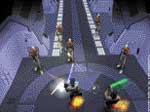This month, we review RAD Technologys flavor (Miles/Dolby) of DirectSound 3D as implemented by the design team of Star Wars: Episode I, The Phantom Menace. (Microsofts DS3D is a component of DirectX 6.1; for more information, see the sidebar in our August 2000 review of FIFA 2000.)
Two back-to-back logo sequences (Lucas Arts and Big Ape Productions the development team) precede the games intro cut-scene, a fairly long cinematic that sets up the premise of The Phantom Menace. But yikes! the games main menu screen acts as a forced intermission even before you get there (you have to click on a Start button in order to proceed). Fortunately, John Williamss glorious score is not interrupted whatsoever by the interface changes. And, exactly as you would expect to see and hear at the beginning of any Star Wars film, once again the famous scrolling text parades against the backdrop of glittering stars, accompanied by Williamss immediately recognizable theme music think big sound!
 The cut-scene continues with an opening reminiscent of the Episode I movie, except that you are introduced to computer-rendered 3D polygonal versions of young Obi-wan Kenobi and Qui-Gon Jinn instead of filmed human actors. Although the audio implementation up to this juncture is splendid, the dialog disappointingly does not sync properly with the (rather odd and unnatural) speech-gestures from the animated actors, and the win-game cut-scene fares no better. At least when the actors walk away from, or towards, the camera, the relative volume of the dialog decreases or increases accordingly. But if there are any ambience adjustments encoded in the design to address the sound of speech moving about in a large room, I cannot detect them.
The cut-scene continues with an opening reminiscent of the Episode I movie, except that you are introduced to computer-rendered 3D polygonal versions of young Obi-wan Kenobi and Qui-Gon Jinn instead of filmed human actors. Although the audio implementation up to this juncture is splendid, the dialog disappointingly does not sync properly with the (rather odd and unnatural) speech-gestures from the animated actors, and the win-game cut-scene fares no better. At least when the actors walk away from, or towards, the camera, the relative volume of the dialog decreases or increases accordingly. But if there are any ambience adjustments encoded in the design to address the sound of speech moving about in a large room, I cannot detect them.
Once past the intro cinematic, you smoothly segue into game mode where you can experience the game-play sounds of the interactive action sequences. You cannot vary the camera view away from the hard-wired aerial POV, but the game engine will occasionally automatically force you into close view. But, regardless of the view, I never had the illusion that I heard elements behind me, which is the ultimate test for two-speaker DS3D.
Seemingly minor details such as real-time footsteps are hard for a development team to pull off in a game. Often it is a failure of coordination between the sound effects designers and the AI programmers responsible for getting them placed and heard in the game. But in The Phantom Menace, there are many instances of footsteps ambulating across varied surfaces. You cant help but be impressed with the work of AI coder Denzil Kriekenbeek and sound designers Clint Bazakian and Julian Kwasmesk for their success in producing this games very effective footstep rhythms and surface-to-room environments. This kind of detail goes a long way to enhance the value of the game play.
Peter McConnells edited music clips are, of course, composed by John Williams, as are the clips on the menu pages. But there are occasions where the music score is not music, but instead elaborate ambience tracks, such as when you are in the Mos Espa Arena (where the pod race happens). Sometimes the ambience will represent the arena crowd (for example, in the outdoor scenes), or it might represent indoor spaces.
The interior of the Mos Espa Arena is a perfect backdrop to emulate the way sound reacts to environments such as large rooms adorned largely of stone and tile, and the sound team indeed seizes the opportunity. This is especially evident with the dialog that takes place in the lounges and corridors of the arena. Unfortunately, when you are in the scene where the lounge band is performing, their music persistently maintains a static stereo mix nevermind if your back or side is turned toward the stage! The only response to the gamers position is the volume of the lounge music, in an attempt to simulate the relative distance from the stage.
If youre a Stars Wars fan (and hardcore enough to appreciate Episode I), and if you enjoy first-person 3D action computer games with decent audio, then this game is for you.
Listening Chain: Toshiba SD-M1202 DVD-ROM drive; M Audio Delta 66 multichannel sound card (with DX driver); JBL 2500 2-way nearfield monitors, no subwoofer.
Knowing the Score So where do the scores we give these discs fit into the scheme of things? Sure, you know that 5.1 is a perfect disc, but what does the rest of the scale mean? Glad you asked. Here is a key to let you know what the scores really mean.
The Score (Out of 5.1)
Overall Rating: 3.0
Content: 3.5
Technical Achievement: 2.5
1 = Adequate
2 = Fair
3 = Good
4 = Excellent
5.1 = Perfection
